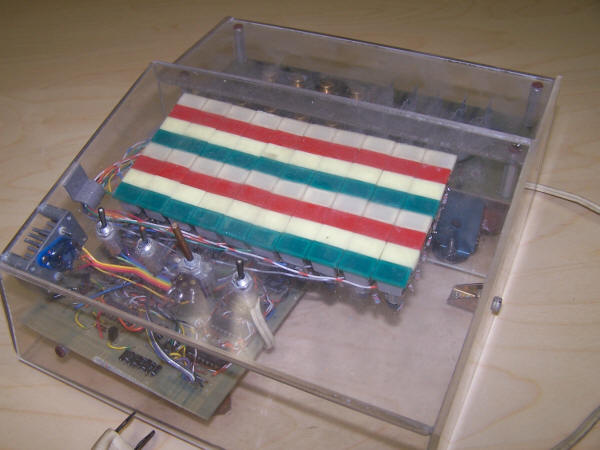RIKLBLOG
|
| Tomorrow |
| 11 August 2006 |
| Yesterday |
| Index |
| Eventide |
| SETI League |
| PriUPS Project |
| Bonus! |
| Contact |
The Thing With the Flashing Lights
I just checked and my Nerd-to-English translator is still unavailable. So instead of a long, incomprehensible babble, how about some nice flashing lights? The "The Thing With the Flashing Lights" has surfaced from the heap during a search for something else. I built the Thing during the era when electronic components were still visible, and computers weren't the wimpy little boxes they are today. If you were a computer operator (as I wasn't), you had before you a "console," and the console had flashing lights to show the internal state of the electronics. I didn't have much use for one of those computers, but the console lamps showed up in surplus stores all the time...
|
|
|
Straight off the storage shelf, complete with dust. (After a decade it doesn't get any thicker.) We didn't use 3-wire grounding plugs in those days — nobody expected to live forever! |
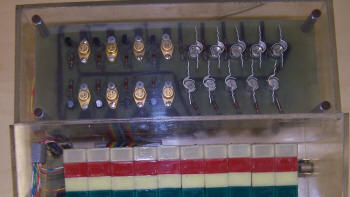 |
The incandescent lamp (remember them?) row drivers and column drivers used individually packaged bipolar transistors (remember them?). |
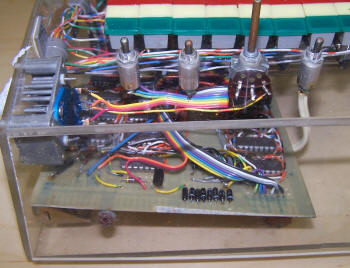 |
Discrete components and ICs are mounted on a thru-hole PC board and wired together with solid-conductor telephone cable wire and hippie-necklace ribbon cable. The cylindrical switches also came from computer consoles. |
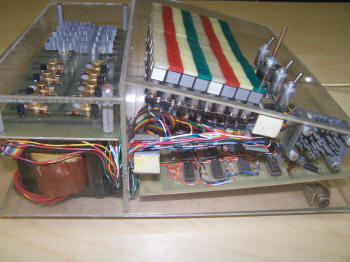 |
This side view shows the power transformer with actual wires coming
out. If the picture were larger you'd see that some of the
the thru-hole ICs have no numbers. Purchased as random surplus,
their functions
were deduced by connecting power to the pins and looking at the outputs.
Many had one bad section, which meant they also had at least one good section. New, known-good ICs were expensive! |
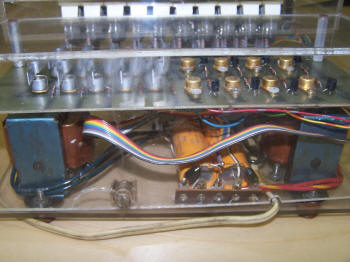 |
The capacitors had leads, too. Switching power supplies were rare then; linear (and heavy) was the way to go. This one had a full wave rectifier. |
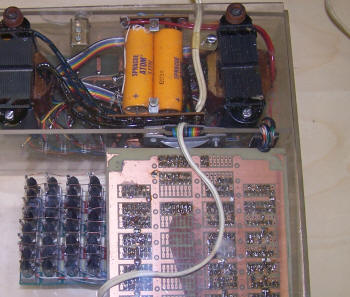 |
The PC board wasn't commercially made. As I recall, I
borrowed some taped artwork and made single-sided boards myself.
I had no way to plate them, so I left them as bare copper.
I think I may have sprayed them with Krylon Clear after
construction. This one seems to be in much better shape
than it could be without some sort of coating. Note the
hand-wiring of the lamp matrix. The mechanical construction was basically Plexiglas sheets and methyl methacrylate monomer. |
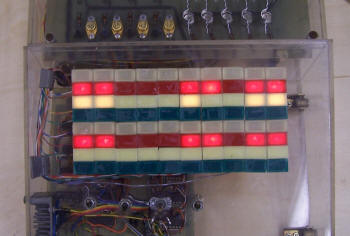 |
Remarkably, it seems to work after 40 years in storage! Which lights are on and off are determined by a shift register with feedback, which produces pseudorandom data. When a row and a column are both on, the lamp at the intersection is also turned on. |
| The real Thing provides hours of entertainment! |
| © 2006 |
| Richard Factor |
